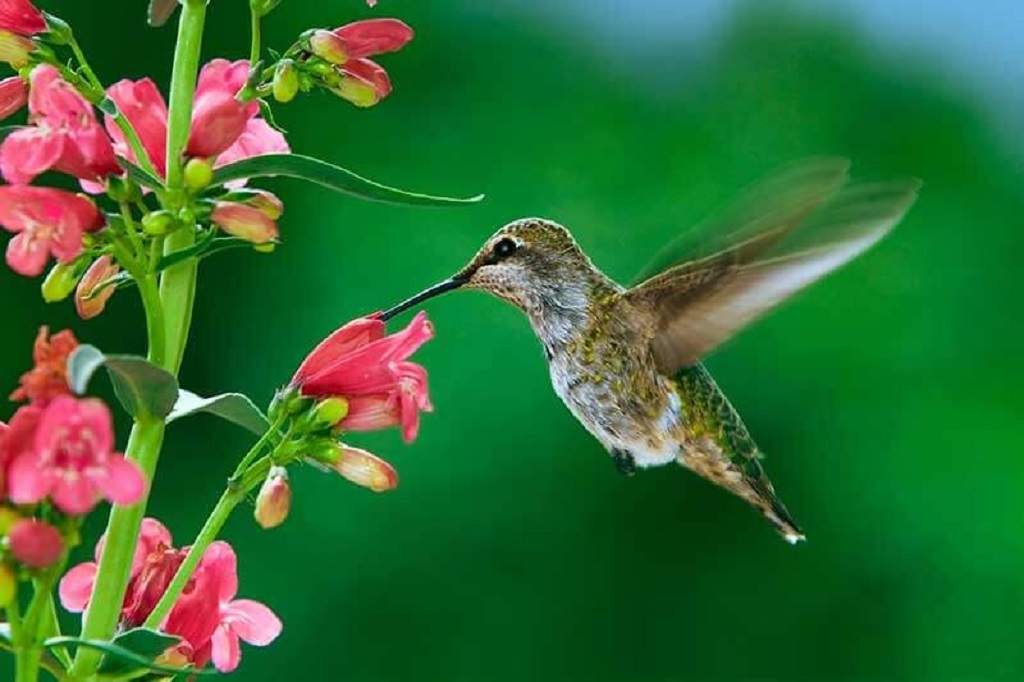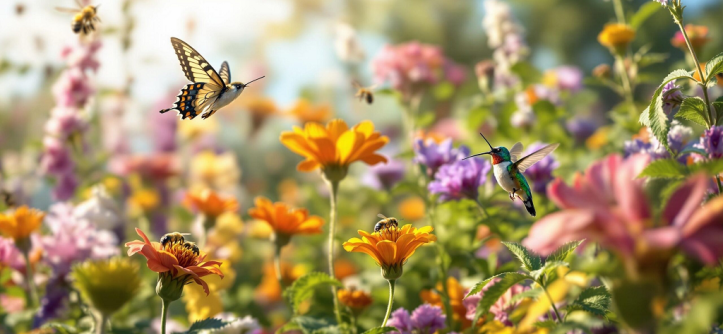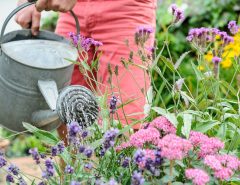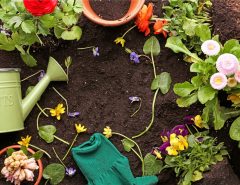Imagine stepping into your garden and hearing the gentle hum of bees, the flutter of butterfly wings, and the rapid buzz of hummingbirds darting between blooms. Pollinators bring life to any outdoor space, turning it into a vibrant ecosystem. These tiny creatures—bees, hummingbirds, and butterflies—play a colossal role in food production and biodiversity. According to the U.S. Department of Agriculture, nearly 80% of global crop plants rely on animal pollination. Yet, pollinator populations face alarming declines due to habitat loss and pesticide use. Creating a pollinator-friendly garden not only boosts your harvest but also supports these vital species. This article reveals practical, expert-backed strategies to transform your garden into a pollinator paradise, ensuring bees, hummingbirds, and butterflies thrive.
Why Pollinators Matter to Your Garden

Pollinators are nature’s matchmakers, transferring pollen to help plants reproduce. Without them, many fruits, vegetables, and flowers wouldn’t exist. The National Pollinator Partnership estimates that pollinators contribute to one in every three bites of food we eat. Bees, for instance, pollinate crops like apples, blueberries, and almonds. Hummingbirds and butterflies aid wildflowers and garden blooms, enhancing biodiversity. However, critics argue that focusing on pollinators diverts attention from broader ecological issues like soil health. While soil matters, pollinators directly impact plant fertility, making them indispensable. By attracting them, you ensure a thriving garden and contribute to global food security.
Choose Native Plants for Maximum Impact
Native plants are the backbone of a pollinator-friendly garden. They’ve evolved alongside local pollinators, offering ideal nectar and pollen. For example, milkweed supports monarch butterflies, while bee balm attracts bees and hummingbirds. The Xerces Society notes that native plants are four times more attractive to pollinators than non-natives. Some gardeners prefer exotic hybrids for their beauty, but these often produce less nectar. To balance aesthetics and function, mix native species like coneflowers and black-eyed Susans with vibrant annuals. Check your ecoregion at Native Plant Trust to find suitable plants. This approach ensures both visual appeal and pollinator nourishment.
Plant a Variety of Flower Shapes and Colors
Pollinators have distinct preferences for flower shapes and colors. Bees favor blue, yellow, and purple blooms with flat surfaces, like sunflowers. Hummingbirds seek tubular red or orange flowers, such as trumpet vine. Butterflies prefer broad, flat blooms like zinnias. A 2023 study from Oregon State University found that diverse flower shapes increase pollinator visits by 30%. Some argue that single-species planting simplifies garden care, but this limits pollinator diversity. Instead, plant in clumps of three to five for easy foraging. Vary bloom shapes—daisy-like, tubular, and clustered—to attract a wide range of pollinators, ensuring constant activity.
Ensure Year-Round Blooms for Consistent Food
Pollinators need food from spring to fall. Early bloomers like redbuds support emerging bees, while late-season asters fuel migrating butterflies. The American Meadows guide suggests using a “bloom season” filter to plan continuous flowering. Critics claim that year-round blooms demand extra maintenance, but choosing low-maintenance perennials like yarrow minimizes effort. Plant early, mid, and late-season flowers to provide a steady nectar supply. For example, spring crocuses, summer salvias, and fall goldenrods keep pollinators fed. This strategy supports their life cycles, especially for hibernating bees or migrating hummingbirds, while keeping your garden colorful.
Create Shelter and Nesting Sites
Pollinators need more than food—they require safe havens. Ground-nesting bees, which make up 70% of U.S. bee species, need bare soil patches. Butterflies seek host plants like milkweed for caterpillars. Hummingbirds nest in dense shrubs. Some gardeners worry that “wild” areas look untidy, but a small brush pile or unmowed lawn corner blends naturally. The USDA recommends leaving dead trees or logs for solitary bees. Add a birdbath with pebbles for safe drinking. These elements create a balanced ecosystem, offering shelter from predators and harsh weather, ensuring pollinators stay in your garden.
Avoid Pesticides to Protect Pollinator Health
Pesticides, even organic ones, can harm pollinators. Neonicotinoids, for instance, contaminate nectar, weakening bees. A 2022 study by the Natural Resources Defense Council found that pesticide use contributed to a 90% decline in monarch butterflies since 1997. Some gardeners argue that pesticides are essential for pest control, but natural alternatives like companion planting work effectively. For example, marigolds deter aphids without chemicals. If spraying is unavoidable, apply at dusk when pollinators are less active. This protects beneficial insects while maintaining crop health, creating a safer environment for bees, butterflies, and hummingbirds.
Add Water Sources for Pollinator Comfort
Water is critical for pollinators, especially on hot days. Bees and butterflies drink from shallow sources, while hummingbirds bathe in gentle streams. A 2024 Gardening Know How article suggests placing a shallow dish with rocks for safe landing spots. Deep birdbaths can drown small insects, so add pebbles or sand. Some argue that water features attract unwanted pests, but regular cleaning prevents this. A bubbling fountain or a muddy puddle adds charm and utility. By providing clean water, you ensure pollinators remain hydrated and active, boosting their presence in your garden.
Incorporate Feeders for Extra Appeal
Hummingbird feeders can draw these birds when flowers are scarce. Use dye-free nectar, as red dye harms hummingbirds, per the Audubon Society. Butterflies enjoy fruit-based feeders with overripe bananas or oranges. Critics claim feeders require frequent cleaning, which is true, but a twice-weekly rinse prevents mold. Place feeders near flowers to encourage natural foraging. This combination enhances your garden’s allure, especially during migration seasons, ensuring hummingbirds and butterflies visit regularly.
Maintain a Pollinator-Friendly Mindset
Building a pollinator paradise requires long-term commitment. Avoid removing spent blooms immediately, as they provide winter shelter. Leave dandelions and clover, which bees love, despite their “weedy” reputation. Some gardeners prefer manicured lawns, but a slightly wild yard supports biodiversity. Educate neighbors about pollinator-friendly practices to amplify impact. The Pollinator Partnership offers regional planting guides at Pollinator.org. By adopting these habits, you create a sustainable haven that benefits both pollinators and your garden’s health.
Featured Snippet: How Can I Attract Pollinators to My Garden?
To attract bees, hummingbirds, and butterflies, plant native flowers like milkweed, bee balm, and coneflowers in diverse shapes and colors. Ensure blooms from spring to fall for consistent food. Avoid pesticides, using natural pest control like marigolds. Provide water through shallow dishes with pebbles. Create shelter with bare soil, brush piles, and dense shrubs. Add hummingbird feeders with dye-free nectar. These steps, backed by the Xerces Society, boost pollinator visits by up to 30%, enhancing garden vitality and biodiversity.
FAQs
What are the best plants for attracting bees?
Bees love blue, yellow, and purple flowers like lavender, sunflowers, and borage. Native plants offer ample nectar and pollen.
How do I attract hummingbirds to my garden?
Plant tubular red or orange flowers like trumpet vine. Add a feeder with dye-free nectar and a water source.
Which flowers attract butterflies?
Butterflies favor flat blooms like zinnias and milkweed. Include host plants like parsley for caterpillars.
Can I use pesticides in a pollinator garden?
Avoid pesticides, especially neonicotinoids. Use companion planting or apply sprays at dusk to minimize harm.
Why are native plants important for pollinators?
Native plants provide optimal nectar and pollen. They’ve co-evolved with local pollinators, ensuring compatibility.
How do I provide water for pollinators?
Use shallow dishes with pebbles or a birdbath with landing spots. Clean regularly to prevent mold.
What’s the easiest way to start a pollinator garden?
Plant native perennials in clumps, add a water source, and avoid chemicals. Start small with pots if needed.
Final Thought
Pollinators are the unsung heroes of our gardens, ensuring vibrant blooms and bountiful harvests. By embracing native plants, diverse blooms, and safe habitats, you can create a thriving ecosystem. Every small action counts—whether it’s planting a single milkweed or skipping pesticides. Start today and watch your garden buzz with life.
Call to Action: Transform your garden into a pollinator haven! Share your favorite pollinator plants in the comments or try one tip from this article. Visit Pollinator.org for a regional planting guide and make a difference now!
Related Topic: How to Make Smooth Allulose Syrup at Home
References:
- “How to Attract Pollinators,” Pollinator Partnership, Pollinator.org
- “Native Plant Trust,” NativePlantTrust.org
- Top-performing articles: “16 Pollinator Plants That Will Attract Birds, Bees, and Butterflies to Your Garden” (Martha Stewart, 2024), “These 8 Enchanting Perennials Attract Pollinators Year After Year” (Gardening Know How, 2025)





Leave a Reply